In recent years, widespread LED lamp which are visually similar to incandescent lamps. LED devices are actively advertised, advertisers report excellent energy characteristics of products, a long service life of light bulbs and powerful lighting.
However, sellers almost never say that the harm of LED lamps largely negates all the advantages of this type of lighting devices. In this article, we will take a closer look at whether LED factors affect health deterioration, and if so, why.
Negative factors
There is a complex of negative effects on the human body caused by LED lighting.
Housings of LED lamps are made of environmentally friendly materials - high-quality plastic and steel. In high power devices, the radiator is made of aluminum alloy. Unlike fluorescent lamps, LED products do not use bulbs with gas.
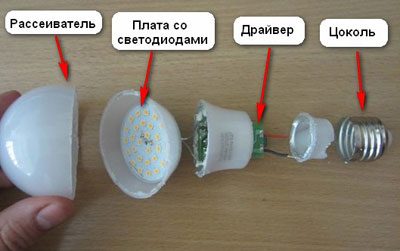
Effect of light on vision
In this case, the so-called color temperature is important - an indicator of the intensity of the radiation of the light source. The higher the temperature index, the stronger the radiation in the blue and blue spectrum. For the eye retina, the most dangerous is too strong blue light, under the influence of which it begins to degrade. Cold white light is dangerous for children, because the structure of their eyes is not yet sufficiently developed and injury is possible.
To reduce the irritating effect of light, it is recommended to "dilute" the light from LED sources with low power incandescent lamps (up to 60 W). You can also use LED devices that give a warm white light. Such light sources (without increased pulsation coefficient) do not cause harm to health.
The color temperature level is indicated on the product packaging. The temperature norm is in the range of 2500-3200 K.
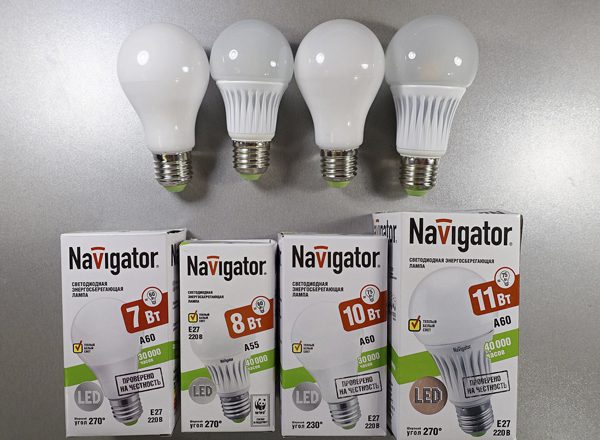
flicker
The harm of LED lamps can be expressed in their flickering at a certain frequency. Frequencies in the range of 8-300 Hz have a damaging effect on the human psyche. Moreover, such flickering is invisible and, nevertheless, can adversely affect the nervous system.
However, it should be noted that in high-quality products, the output voltage of the driver is carefully filtered, as a result of which the variable component is reduced to nothing. In this way, the ripple level can be reduced to less than 1%. If the lamp is mounted impulse block supply, the ripple factor can reach up to 10% without harming a person.
Note! Devices with good drivers are not cheap. Savings in this case can only be done to the detriment of health.
Influence on the release of melatonin
A hormone called melatonin is responsible for the quality of sleep, its rhythm and frequency. Melatonin also stabilizes oxidative processes at a safe level, which slows down the aging process. In a healthy person, this hormone reaches its maximum concentration with the onset of darkness. The result is a desire to sleep. When working at night, the body is exposed to many irritants, including artificial lighting. Prolonged and regular exposure to led light especially negatively affects the quality of vision.
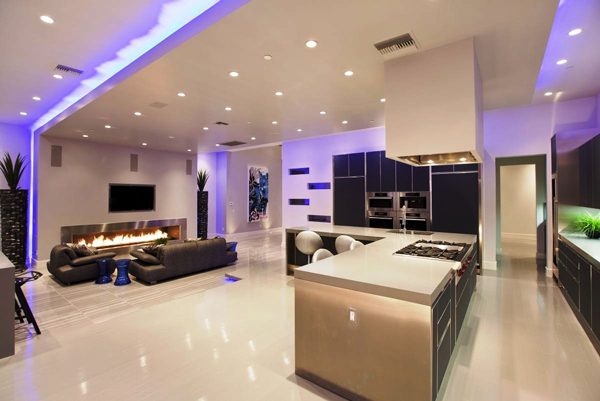
Note! Long stay near the monitor LED backlight is one of the contributing factors to insomnia.
Electromagnetic radiation
The harm of LED lamps associated with electromagnetic radiation is considered exaggerated. High-frequency pulses really degrade the signals of radio equipment and Wi-Fi receivers in the vicinity. However, for the human body, LED lamps are much less noticeable compared to mobile phones or microwave ovens.
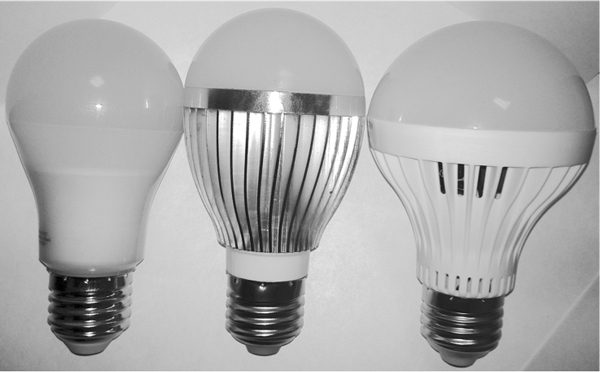
Ultraviolet and infrared radiation
To get an answer to the question about the dangers of ultraviolet and infrared rays, it is necessary to analyze two options for obtaining white LED light. In the first case, three crystals are placed in the case - white, red and green. The experiment shows that the wavelength does not leave the limits of the visible spectrum, which means that the LEDs do not create a stream of light in the ultraviolet and infrared ranges.
The second option involves obtaining white light by applying a phosphor to a blue LED. As a result of mixing the white stream created by the phosphor and the yellow stream from the LED, various shades of white are obtained. The results of the experiment show very low ultraviolet radiation, which is safe for the human body. The intensity of infrared radiation at the beginning of the long wavelength range is within 15%, which is much less than in the case of a standard incandescent lamp.
Standardization of LED lamps
There is a strong opinion that LED lighting products are not standardized. In part, this statement can be considered incorrect. Yes, there is no separate standard, but LED lamps are described in the general regulatory documentation, which normalizes the effect of artificial light on a person.
For example, in one of the paragraphs of GOST regarding photobiological safety, the conditions and methods for calculating the characteristics of lamps, including LED ones, are indicated. In accordance with the letter of the regulation, all continuous wave lighting devices are divided into four groups according to the level of danger to vision. Risks are determined based on the results of the experiment as a result of measuring the levels of ultraviolet and infrared radiation. The nature of blue light and the effect of heat on the retina are also analyzed.
One of the paragraphs of the Code of Rules regulates the requirements for different types lighting. So, for example, LED devices are mentioned in the section "Artificial lighting". Normalized technical specifications lighting equipment, it is indicated that its characteristics should not go beyond the values \u200b\u200bspecified in the rules.
For example, for artificial lighting lamps, the color temperature can range from 2400 to 6800 K, and the highest level of ultraviolet radiation is fixed at 0.03 W per square meter. It also describes the allowable pulsation, luminous efficacy and illuminance factors.
Products from Chinese manufacturers
The dangers of cheap products are mentioned above. LED devices from Chinese manufacturers can generally be described as low quality. Products cheaper than 200 rubles per unit are often equipped with a low-quality voltage conversion unit. Instead of drivers, such models are equipped with a power supply without a transformer, which neutralizes the variable component using a polar capacitor. At the same time, a small capacitance does not allow the capacitor to carry out full neutralization. As a result, the ripple factor in some cases reaches 60%, which is extremely harmful to the human eye and psyche.
There are two ways to reduce the negative impact of such products. In the first case, it is necessary to replace the electrolyte with an analog with a capacity of about 470 microfarads (if this is technically possible). In any case, such lamps can only be used in rooms with low eye strain (toilet, corridor, etc.). Another way involves replacing a low-quality unit with a driver with a pulse-type converter.
Note! Many experts say that the harm caused by LED lamps is exaggerated. However, it is recognized that the problem of blue light has not yet found a solution, and therefore you need to pay special attention to the color temperature.
If the value of the K parameter exceeds 4 thousand units, you should refuse to purchase such LED lamps. Such lighting fixtures are designed to illuminate streets and industrial premises.
LED lamps and LED lightening in general is used in our lives more and more often. It is used to illuminate industrial and domestic premises, residential buildings, streets, and is also used in computer screens, TVs and other gadgets. And this is justified. With our very small energy consumption, we can get a powerful luminous flux and long term services. But today we are not interested in this. We are interested in the safety of LED lamps, their impact on human health and physiology, and the harm of LED lighting.
Without a doubt, incandescent lamps are the safest, they do not contain any complex components and heavy metals, they do not emit ultraviolet radiation, they do not flicker and they emit light most similar to natural light. With the advent of lamps daylight began to think about their safety. They contain mercury vapours, which will cause very negative effects when the lamp is broken, constantly flicker and it adversely affects the eyes, and also emit electromagnetic radiation due to the use of electromagnetic coils.
When LED lamps appeared, it seemed like a panacea, they consume a minimum of energy, do not contain harmful substances and almost no flicker. But is everything as good as it seems? In this article, we will try to figure it out. Undoubtedly, the safety of LED lamps is higher than daylight, but they have their own dark side.
Light safety
Scientists from Spain working at the University of Madrid have found that looking at an LED lamp for a long time can damage your eyesight. Most LED lamps use a combination of blue and yellow LEDs to produce white light. The yellow diode is not dangerous, but the blue one can cause problems. It emits blue and purple very short wavelength with great energy and power. Prolonged and uninterrupted staring at such a light source can damage the retina of your eye. LED lamps cause three types of injuries to our eyes: photomechanical (shock energy of a light wave), photothermal (heating of tissue from radiation) and photochemical (photons of light can cause chemical changes in molecules).
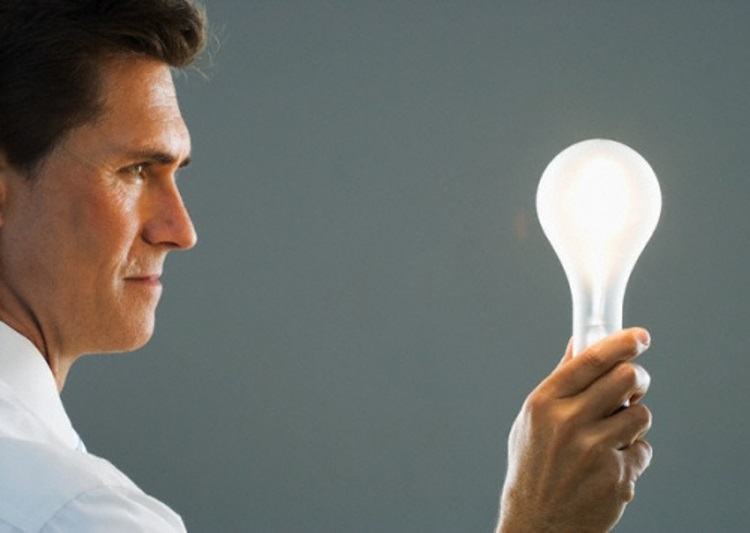
But this shortcoming is easy to deal with. Just do not look at the bright LED lamp for a long time. The same rule applies to fluorescent lamps, they are much more harmful in this regard, since they emit direct ultraviolet light, which is incomparable to the radiation of LED lamps in terms of harm to the eyes. It was necessary to mention the dangers of the light of LED lamps so that you do not think that they are safe in this regard.
LED lamps and physiology
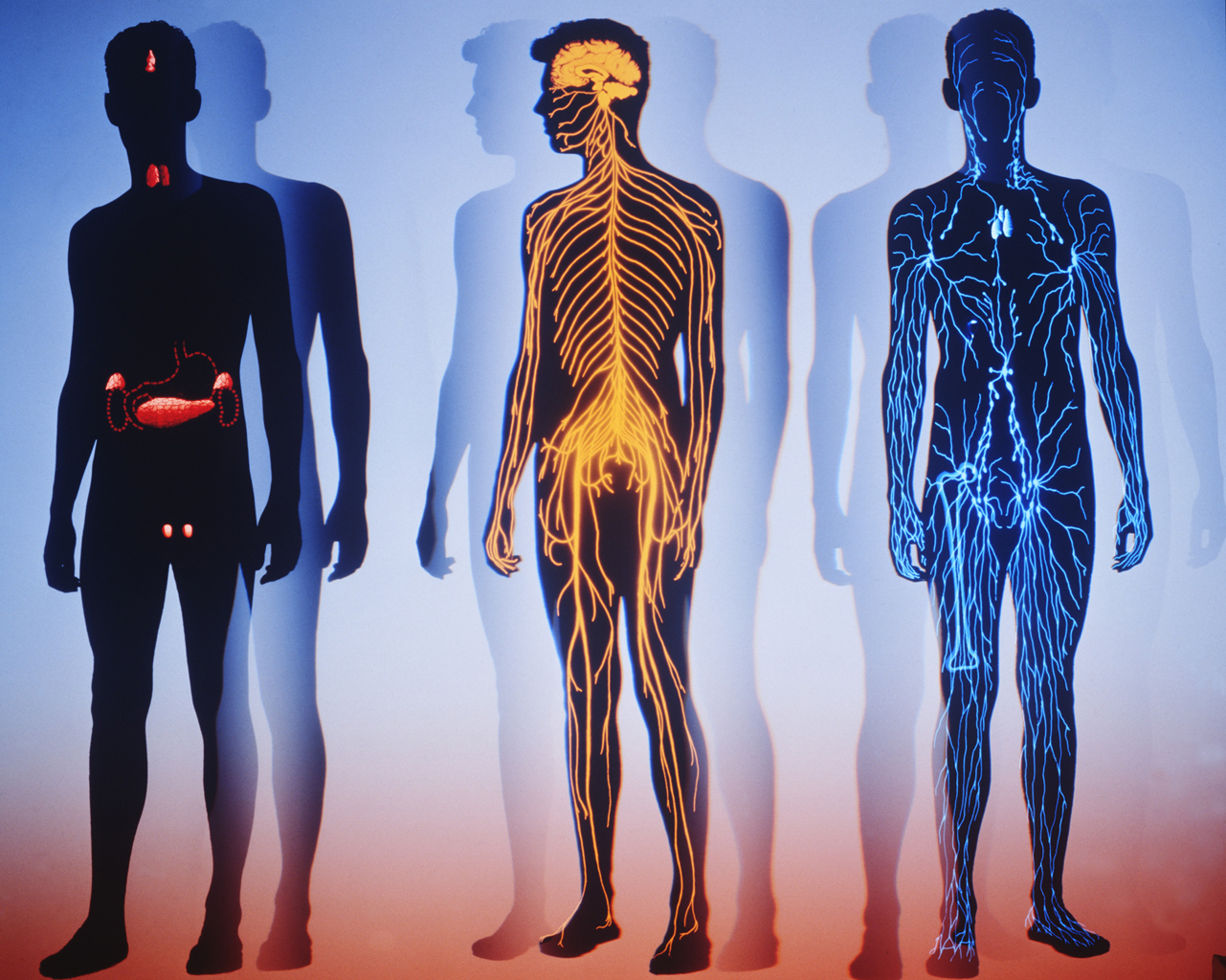
Israeli scientists conducted a study on the effect of lighting on the release of the hormone melatonin. It is produced by the pineal gland and affects sleep patterns, blood pressure and brain function. But most of all, this hormone controls sleep, the more hormone in the blood, the stronger man wants to sleep.
Scientists have found that white and blue colors reduce the release of melatonin. The blue, bright color has the greatest effect on the release of this hormone. This happens because over the centuries our body has become accustomed to the fact that in blue light, you need to be awake during the day, and in yellow light, when the sun sets, it's time to sleep. This harm of LED lamps applies to any bright artificial light sources. For bedrooms, it is recommended to use incandescent lamps or LED lamps with a low color temperature - 1000-1500 Kelvin. It is also recommended not to look directly at a bright light source two to three hours before bedtime.
Harm flickering lamps
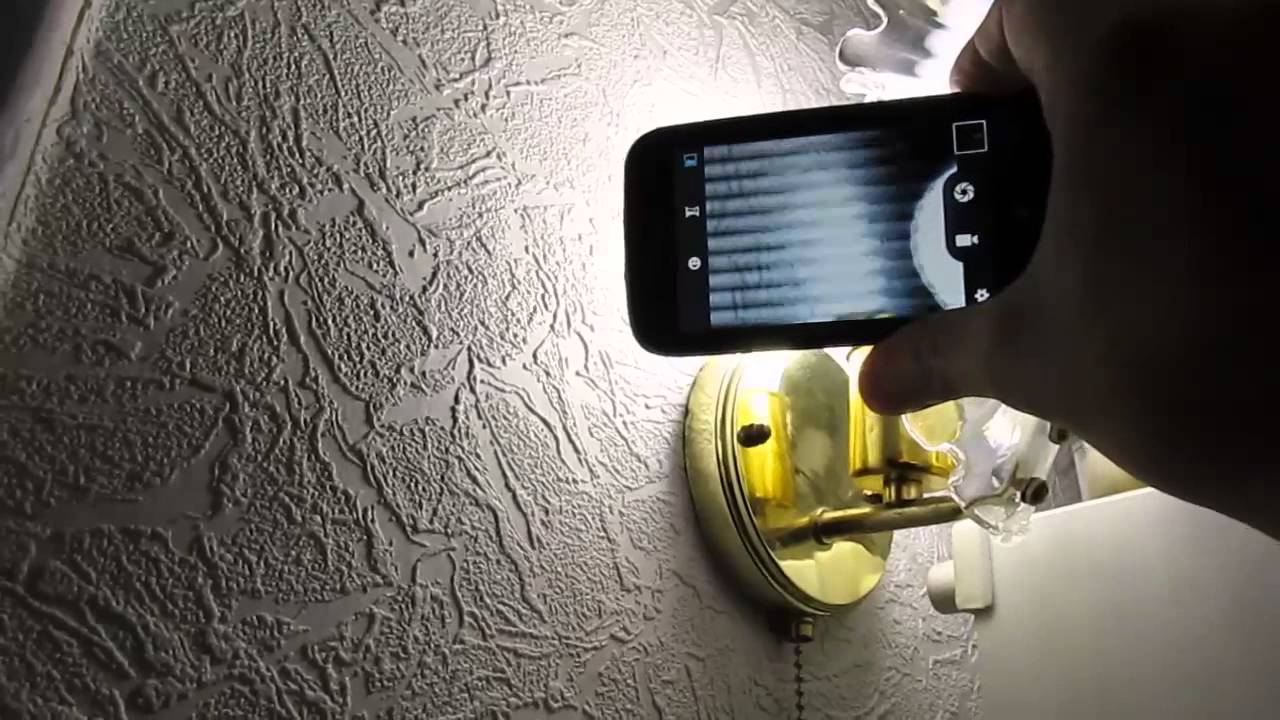
It would seem that LED lamps do not flicker, but not everything is so simple. In fact, all the lamps flicker, we just cannot see it. Even incandescent lamps powered by mains alternating current flicker at 100 Hz. Poor-quality LED lamps can flicker even at a lower frequency. LEDs need to work D.C., and there is a variable in the network, the easiest way to get direct current is to weed out part of the pulses, which will give an uneven flow of electricity and, as a result, flicker. Our consciousness is not able to notice the flickering of lamps due to its inertia, but the brain can fix it up to a frequency of 300 Hz. Fluctuations of low-quality LED lamps can cause some harm to the body, they change the hormonal background, reduce performance, increase fatigue.
In high-quality LED lamps from well-known manufacturers, the flicker frequency is up to more than 300 Hz and our brain cannot fix it, therefore it does not affect. This reduces the flickering of the lamp to zero. You can check if your lamp is flickering by looking at it through your phone's camera. If the flicker frequency is below 100 Hz, you will most likely see flicker. See details:
Electromagnetic radiation
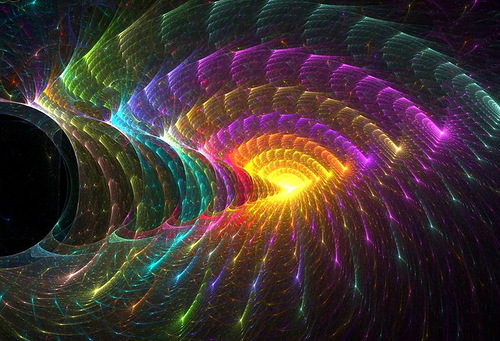
electromagnetic radiation safety
Each LED lamp contains an electrical circuit. As I said, to power the LEDs, you need constant pressure. Therefore, to convert AC voltage to DC, a special circuit diagram, generating impulses high frequency(to avoid flicker). Electromagnetic interference is created around the light bulb, which can interfere with the operation of household appliances. It is not recommended to place devices such as radios, televisions or other sensitive equipment close to the lamp.
Heavy metals and hazardous substances
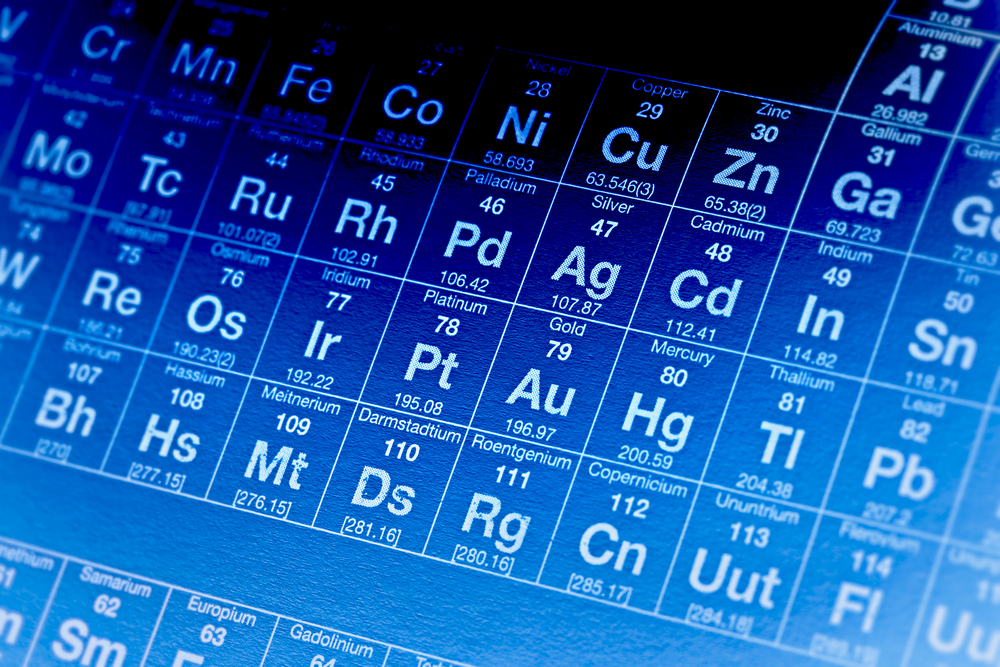
Unlike fluorescent lamps, LED lamps do not contain any hazardous elements. All that is here is a completely safe semiconductor from which the LED, lens and case plastic are made. Fluorescent lamps contain mercury vapor, while the lamp is sealed, it is completely safe, but when the integrity of the housing is broken, and mercury spreads throughout the room, it can cause damage to the respiratory system. But, fortunately, such a disadvantage is not inherent in LED lamps.
fire safety
![]()
In this aspect, the safety of LED lighting is also on high level. As you know, ordinary incandescent lamps get very hot, and if you touch a non-working light bulb, you can get burned. But the LED lamp will be barely warm even after several hours of operation. It does not heat the air around it and will not cause a fire even if it comes into contact with flammable substances.
Danger of direct light
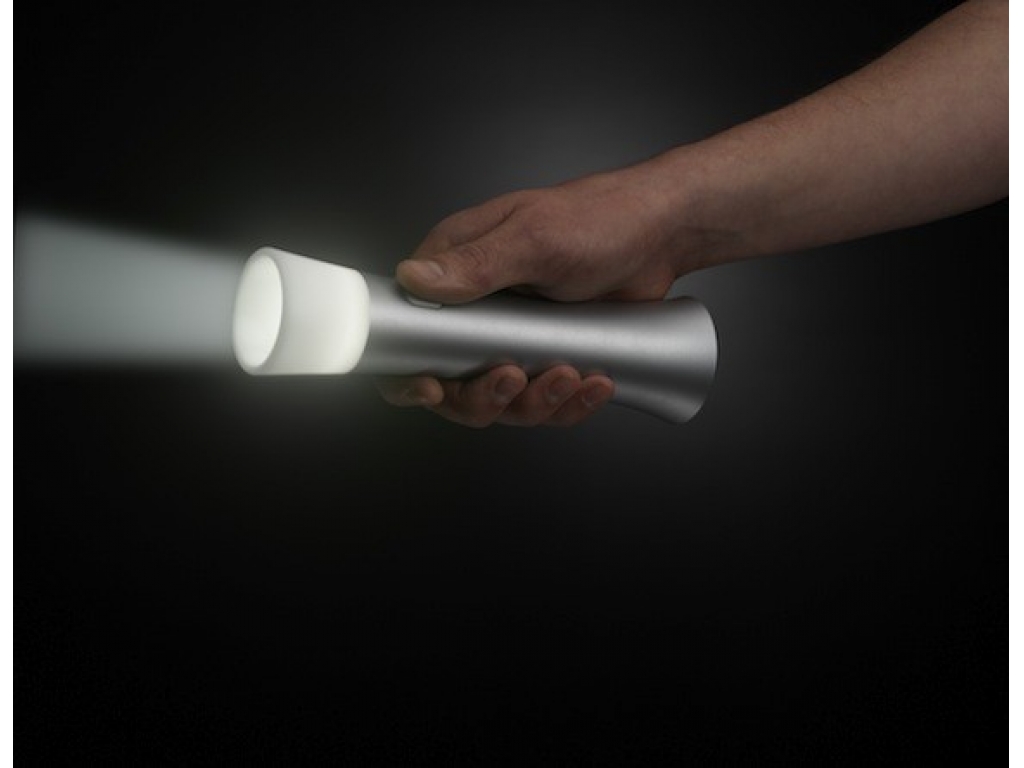
harmful direct light
Looking at bright light sources is not recommended. This can cause serious damage to your eyes and cause retinal burns. If you hold your eyes for a few seconds on an incandescent bulb or most LED lamps with a diffuser, then most likely there will be no problems. But a direct hit of a bright, unscattered light beam can damage the retina. This does not apply much to household LED lamps, but is suitable for other devices, such as flashlights.
conclusions
LED lamps are not as dangerous as fluorescent lamps. They do not contain any harmful substances that can be released into the atmosphere if you break the lamp, they do not have very harmful low-frequency flicker that affects the eyes, but they still have disadvantages that you need to learn how to get around. Now you know what to consider when buying an LED lamp. The harm of LED lamps can be minimized by choosing a quality product. First of all, you need to take a quality product that will not harm your health and will last you a very long time.
If you find an error, please highlight the text with the error and click Ctrl+Enter.
Post Views: 4,833
Technological progress is advancing by leaps and bounds. More and more new technologies are firmly entering the life of people. Who would have thought that thirty or forty years ago, at home there would be no need to buy incandescent lamps that have tungsten filaments at their core.
A lot has already been said about the advantages of LED-lamps (from the English Light-Emitting Diode). It is low power consumption, long service life, safety and ecological cleanliness. It is worth studying in more detail the question, is LED lighting harmful? Maybe it's a myth? And if this is a reality, how does it affect human health, and can the body withstand undesirable factors.
The first LEDs were created back in the 20s of the last century, but the application began in 1962. A real boom began in recent years. Some believe that they are the future.
LED lamp device
The LED lamp includes a hemispherical diffuser, chip-based LEDs, thermal printed circuit board, a driver for trouble-free operation, a polymer base that serves as a flashover protection and a nickel-plated brass base that creates a connection with the cartridge
White LEDs are more commonly used as lighting. There are suggestions that light bulbs will soon be replaced by LED-like lighting. So in recent years, increased demand has increased supply, light output has increased by 1.5 times, and the price has fallen by three times. Our industry has started manufacturing LED lamps using the latest technology. Outwardly, they already differ little from the traditional "Ilyich's bulbs", but the principle of operation is completely different.
The harmful effects of lamps and ways to reduce it
color effect
What can be the harm of LED lamps. For vision, the intensity of radiation in the blue spectrum is not a very good component. It has been proven that blue tones have a negative effect on the retina. And those at the developmental stage, children's eyes are affected. To reduce the effect of LED bulbs on the organs of vision, there is a recommendation to “dilute” them with low-power incandescent lamps (about 60 W), that is, do not use pure LED lighting, but make it combined, and also prefer using warm colors.
Usually the color temperature is indicated on the packaging. The most pleasing to the eye is considered a yellow tint. This corresponds to 2700 K. The higher this figure, the colder the shade. But being in a room with a predominance of red spectrum lamps all day long is also the wrong method of choosing a lighting system. Blue spectrum radiation favors efficient work. With it, attention is concentrated, so it is better to use cold-colored lamps in industrial and educational premises.
It is important to remember that it will never replace the natural. Therefore, during daylight hours, it is imperative to be outside, especially in sunny weather. Adults need to be outdoors in order to maintain cortisol levels. daytime 30-40 min. per day. Children for the prevention of myopia need to walk 2-3 hours a day.
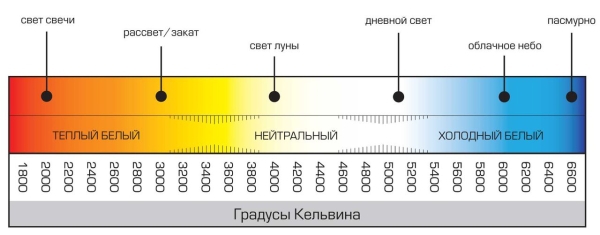
Pulsations and their effect on the organs of vision
The harm of pulsations that artificial lighting sources have has also been proven. Flickers are even invisible to the eye, but they act on the brain and central nervous system, which leads to a deterioration in well-being. Influence is no exception. But in lamps from reliable manufacturers, the output voltage of the driver has good filtering. As a result, the variable component is reduced to a minimum, and the magnitude of the ripple is less than 1%. Therefore, when choosing quality products, it is better to give preference to trusted companies in order to reduce the harm from LED lamps. Cheap Chinese fakes have no place in the apartment.
Electromagnetic influence
Are LED lamps harmful in terms of magnetic radiation? The answer is clear. Impulses from a high-frequency driver can interfere with the performance of radios and televisions that are nearby, but cannot significantly affect a person.
A mobile phone, microwave oven or router is an order of magnitude more dangerous, so the negligible driver radiation should be neglected.
UV and IR radiation
The myth that there is a large infrared and ultraviolet radiation should be dispelled. Having carefully studied the spectral analysis, as well as the manufacturing technology, we can conclude that bad influence unwanted rays does not fall outside the desired range. Studies have shown that in this case they are scanty and harmless.
Hormonal effects
There are recommendations to limit LED lighting before bed, as the light negatively affects the secretion of a hormone called melatonin. Violations of its production leads to a deterioration in the general condition, weakness, diseases of the internal organs up to oncological ones.
Blue light is especially dangerous. In order to avoid violations of the regime and failure of the body, dim lighting in warm colors should be installed in the bedroom.
How to fix a cheap low quality module
It should be noted that in cheap lamps of Chinese origin, a low-quality voltage conversion module is installed. Instead of a driver, it puts transformerless unit power supply with a capacitor having polarity. It serves to reduce the variable component to zero. But a small capacity does not allow one hundred percent to cope with the task, and does not fully perform its function. The ripple factor in this case can be 60%. The quality of the light is degraded, which can drastically impair vision and affect health safety.
Experts advise replacing this type of capacitor with a similar one with a capacity of 470 microfarads, if the dimensions of the lamp housing allow.
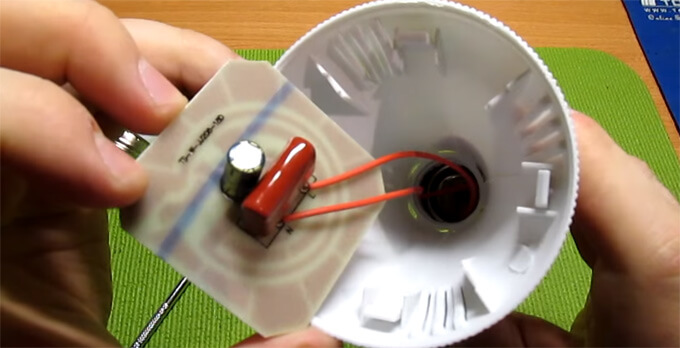
Conclusion
All of the above about the dangers and benefits of LEDs allows us to conclude that the fear of negative impact is unfounded, and all rumors of harm are clearly exaggerated. However, when choosing the type of lighting, you should carefully study the range and take into account the color temperature. To illuminate apartments, you should purchase lamps with a value of T \u003d 3000 K, for bedrooms from 2500 to 3000 K with a predominance of warm tones. Switching to these types of light bulbs or sticking with traditional daylight bulbs is an individual desire for each person. Weighing all the pros and cons, giving preference to one or another type of light sources, it should be remembered that some scientists demand to tighten the standards for the use of bright sources, for example, for a white LED. The use of light bulbs that meet all quality standards is, first of all, a guarantee of good vision. No need to save on your health by buying cheap products.
And in conclusion, one more addition: some types of LEDs that are used in Christmas tree garlands, car headlights, contain lead and arsenic, which are very harmful both to humans and to humans. environment. But, nevertheless, LED lamps are more economical and less dangerous than all previously known types of lamps. Pollution from them is much less than from mercury-containing fluorescent lamps, and the light output is higher than that of incandescent bulbs. This information is thought-provoking and gives reason to carefully approach the choice of LED lighting.
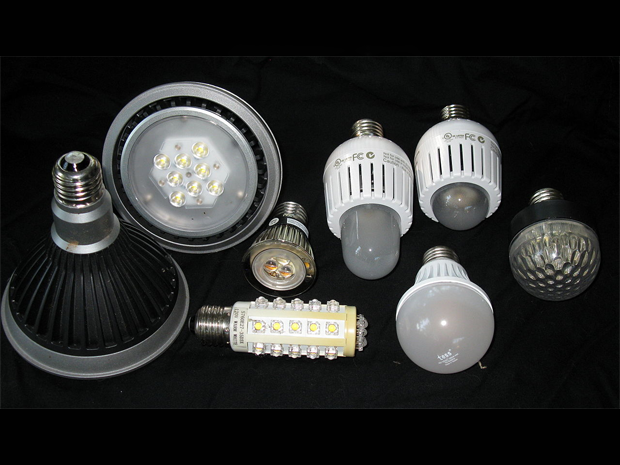
LED lamps have recently become a popular topic for discussing the benefits of new energy-saving technologies in lighting. When it comes to saving energy, everyone is already well aware of the benefits that LED lamps have.
But, …
But it turns out that LED lamps can bring certain benefits to human health.
Fluorescent, metal halogen lamps and other discharge lamps, as well as incandescent lamps, generate vibrations luminous flux not visible to the human eye. Sometimes, as in the case of fluorescent lamps, where the frequency of oscillation is not too high, you can notice the flickering of the lamps. It is clear that the human eye will tire faster under the influence of such lighting. The consequence of such daily fatigue can be visual impairment.
The most harmless to human eyes of the above types of lamps are halogen lamps. The flicker frequency of such lamps is the highest. The most harmful fluorescent lamps. These lamps have the most low frequency fluctuations.
As for LED lamps, LEDs, as a light source, do not create vibrations that are harmful to the eye.
The light of LED lamps is pure and does not contain harmful UV radiation. Of course, modern halogen and metal halide lamps, as sources of increased UV radiation, have UV filters in the glass. But even these security measures can only minimize harmful radiation.
Let me remind you that ultraviolet radiation can cause cancer. Therefore, well-known manufacturers such as BLV, PHILIPS, OSRAM, GE use filters for their lamps without fail. LED lamps, as you understand, do not need filters.
source heightened danger fluorescent lamps, including CFLs (compact fluorescent lamps), are recognized for human health in the United States. The fact is that mercury vapor contained in fluorescent lamps can, if the lamp breaks, cause serious illness or even death. This is not a joke! In America, several lawsuits have already been filed against manufacturers of fluorescent lamps!
LED bulbs won't do any harm human body even if they break. LEDs are non-toxic and do not emit any harmful substances into the atmosphere.
LED bulbs are not just LEDs. The components of LED lamps are aluminum reflectors, metal bases, parts of microcircuits for LED power devices, and glass.
Aluminum products, when it comes to dishes or cutlery, can be harmful to health after many years of use. Aluminum accumulates in the body over time and can cause serious metabolic disorders. However, we are not going to eat LED lamps!
As for other potentially hazardous parts of LED lamps, the glass used in LED ball, candle or T8 LED lamps is not glass at all. This is a thin translucent plastic that, even if it breaks, will not cut anyone!
Chip parts used in LED lamps, of course, may contain heavy metals or other harmful compounds. But you can get serious poisoning with these amounts of harmful substances only with prolonged direct contact or eating.
LED lamps do not have infrared radiation. By itself, infrared radiation, as scientists say, is harmless to humans. But, in my opinion, the less any radiation, the better. The absence of infrared spectrum LED lamps in the light turns out to be very useful from another point of view. When lighting various objects with LED lamps, the light of LED lamps does not interfere with infrared sensors and video cameras. Enterprises offering security systems have already noticed this positive aspect.
Still, it's worth being honest and saying that LED lamps create radio interference for FM receivers. This amazing fact we discovered recently, in the course of replacing a failed incandescent lamp with an LED lamp in our office. Near the installation site of the LED lamp, at a distance of no more than 1 meter, there was an FM receiver. Apparently, the lamp power supply device gives these interferences. In general, FM radio waves are not a source of danger to human health. However, it is still necessary to warn about this fact.
Another positive characteristic of LED lamps is the absence of thermal radiation. LEDs generate heat, but it is absorbed by the aluminum reflector of the LED lamp. The amount of heat generated is several times less than that of incandescent or "halogen" lamps.
Summarizing all of the above, LED lamps are practically harmless to human health. The greatest benefit of LED lamps when used in indoor lighting can bring human vision. Here and the absence of flicker and harmful radiation. Also, LED lamps will help to avoid harmful effects on the skin. And if it happens that the LED lamp breaks, then you will not be poisoned by mercury vapor, as is the case with CFLs.
In recent years, the population has become widespread led light bulbs . Suppliers of these products assure customers that the lamps are economical, durable and shine much brighter than incandescent lamps. It seems that such products are quite useful, since promotion takes place even at the state level. It's no secret that many public institutions are massively changing old lighting fixtures for innovative fixtures. Despite such active advertising, some people are wondering if LED lamps are harmful to human health, and if so, how it is expressed.
Advantages of LED lamps
 To date LED light bulbs are the most economical source of lighting, which has a number of special advantages over incandescent and fluorescent lamps. The main advantages can be highlighted as follows:
To date LED light bulbs are the most economical source of lighting, which has a number of special advantages over incandescent and fluorescent lamps. The main advantages can be highlighted as follows:
- There are absolutely no fragile elements in the lamp - glass bulbs.
- The device lights up instantly.
- There are no filaments, which are considered a weak link in fluorescent lighting devices.
- The constant development of the industry and the ability to use these devices for many purposes, since the size of the LEDs is minimal.
- Low consumption electrical energy allows such bulbs to work even from batteries.
And the biggest advantage is that these lighting devices do not contain harmful substances in their construction, like fluorescent lamps. LEDs do not need to be handed over for recycling, since they do not contain mercury, but whether they are harmful to health is the second question.
Fluorescent lamps are hazardous to the environment because the tubes contain mercury. After burning out, such lamps must be handed over for recycling. LED light bulbs are completely safe in this regard.
General characteristics of LEDs
LED bulbs are made from environmentally friendly materials - high quality plastic and metal. For high power devices, an aluminum alloy is used. The main difference between LED lighting devices and fluorescent lamps is that there is no gas in the flasks.
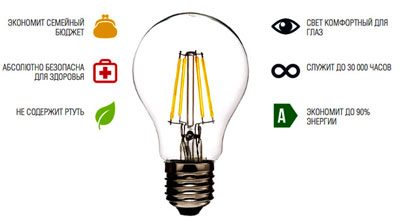 However, the LED cannot yet be considered a full-fledged lighting device, in a standard network the voltage is 220 W, while the LED needs only a few volts to work. In addition, even with a slight increase in relation to the nominal value, the current passing through the device increases many times over. Because of this feature, to include such a lighting device in a standard network, it was necessary to install a special driver.
However, the LED cannot yet be considered a full-fledged lighting device, in a standard network the voltage is 220 W, while the LED needs only a few volts to work. In addition, even with a slight increase in relation to the nominal value, the current passing through the device increases many times over. Because of this feature, to include such a lighting device in a standard network, it was necessary to install a special driver.
Each light bulb is assembled from a group of LEDs that are connected in series. A special driver provides such a voltage in the circuit that the current passing through it becomes nominal. Besides, AC voltage network levels out and becomes permanent.
To many people, all these transformations may seem strange and meaningless, because the LED is already able to pass electricity in one direction. There is a logical explanation for this, if the LED works directly from the network, then the supplied light will be pulsating, with a frequency of 50 Hz.
The industry produces LED light bulbs with different glow warmth. Thanks to this, a person can choose the light that is most pleasant to him.
Where do light pulses come from?
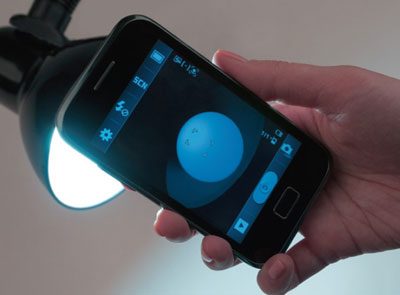 Any devices that operate from a standard network pulsate, but each in a special way. An unpleasant pulsation is smoothed out by an incandescent lamp, since the filament in the bulb has thermal inertia. In the same time fluorescent lamps are very pulsating and this affects the eyes. You can get rid of this if you power the lamps from different phases or shift the phase between them using a special capacitor.
Any devices that operate from a standard network pulsate, but each in a special way. An unpleasant pulsation is smoothed out by an incandescent lamp, since the filament in the bulb has thermal inertia. In the same time fluorescent lamps are very pulsating and this affects the eyes. You can get rid of this if you power the lamps from different phases or shift the phase between them using a special capacitor.
Experts identify a number of lighting devices that have minimal ripple, these include:
- fluorescent light bulbs with semiconductors;
- small fluorescent lamps;
- led light bulbs.
But it’s not worth it to be very happy that such lamps are screwed into the dwelling. Residents are not immune from harmful pulsations. LED light bulbs are the most expensive products among all economical lighting devices. And here the laws of the market already operate. Everyone knows that consumers are more likely to purchase the product for which the price is lower. But manufacturing companies will definitely not work at a loss.
To reduce the cost of LED light bulbs, manufacturers reduce the electronic elements in the driver circuitry. The electrolytic capacitor smooths out the ripple, which filters the rectified voltage. If the driver becomes cheaper, then the capacitance of this capacitor decreases. Some manufacturers install low quality drivers that fail quickly. And especially unscrupulous companies may not install drivers at all.
It is impossible to determine that there is no driver in the LED bulb. This can only be done with special devices, which, by the way, are not even available in all SES.
When buying light bulbs, you should not chase too cheap appliances. In this case, the proverb - a stingy man pays twice - is more true than ever.
The harmful effects of pulsations on health
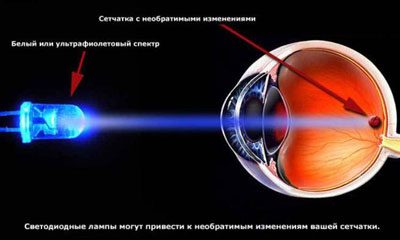 Not all people are aware of the dangers of LED lamps for vision, and low-quality devices really affect the eyes and lead to such conditions:
Not all people are aware of the dangers of LED lamps for vision, and low-quality devices really affect the eyes and lead to such conditions:
- There is severe eye fatigue.
- Retinal disorders develop.
- Visual acuity gradually decreases.
Although people do not notice pulsations, the organs of vision clearly react to them and try to transform the resulting image in such a way that it is evenly illuminated and without pulsations. However, the eyes cannot withstand such loads for a long time, and after a short time, a person notices that the vision is steadily declining, the eyes begin to hurt.
Constant pulsations are of particular danger to children and adolescents. This is due to the fact that their organs of vision are in the stage of formation.
What does medicine say
 The negative impact of LED lamps on the retina has already been fully proven.. At the same time, blue LEDs have the most harmful effect, although others color temperatures not far from them. Sanitary standards and the rules do not include LED lamps in the list of lighting equipment that is allowed for use in preschool and school institutions.
The negative impact of LED lamps on the retina has already been fully proven.. At the same time, blue LEDs have the most harmful effect, although others color temperatures not far from them. Sanitary standards and the rules do not include LED lamps in the list of lighting equipment that is allowed for use in preschool and school institutions.
But, despite the unspoken ban, LEDs that have not been fully studied are already being observed in many kindergartens and schools. Doctors are sounding the alarm and repeating that the eyesight of schoolchildren is steadily deteriorating, but for the sake of objectivity it is worth noting that the lamps are most likely not to blame for this. In recent years, there has been a dramatic technological progress, and children of all ages spend a lot of time on computers and smartphones.
How to choose a good LED light bulb
How can an ordinary buyer choose high-quality lighting sources for his home, because the usual incandescent lamps can already now be found not in all stores. Moreover, people, having seen enough advertisements from TV screens, are increasingly striving to purchase such a newfangled invention as LED lamps.
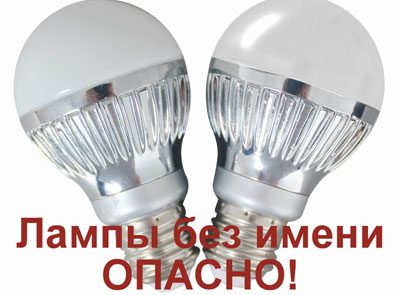 In order not to harm your health and the health of your children, it is necessary to take into account the following recommendations of experts when buying lighting equipment:
In order not to harm your health and the health of your children, it is necessary to take into account the following recommendations of experts when buying lighting equipment:
- Do not chase cheap bulbs of dubious quality, after all, lighting devices that are equipped with high-quality drivers, by definition, cannot be cheap.
- Before buying, you need to carefully read all the information on the package. It is advisable to buy products from well-known manufacturers.
- For residential premises, it is best to purchase light bulbs that correspond to a light temperature of 2700˚K - 3000˚K.
- Having chosen LED bulbs, you should not immediately buy a large batch, it is better to buy a couple of pieces and test. If there is no discomfort for the eyes within a week or two, then you can stop at the products of this manufacturer.
- It is undesirable to use LED lamps to illuminate places for schoolchildren to study..
On the shelves of hardware stores you can find many different lighting lamps, but LEDs remain the most popular today. These devices are economical, durable and environmentally safe. But in order not to harm your health, you need to buy products from trusted manufacturers.





